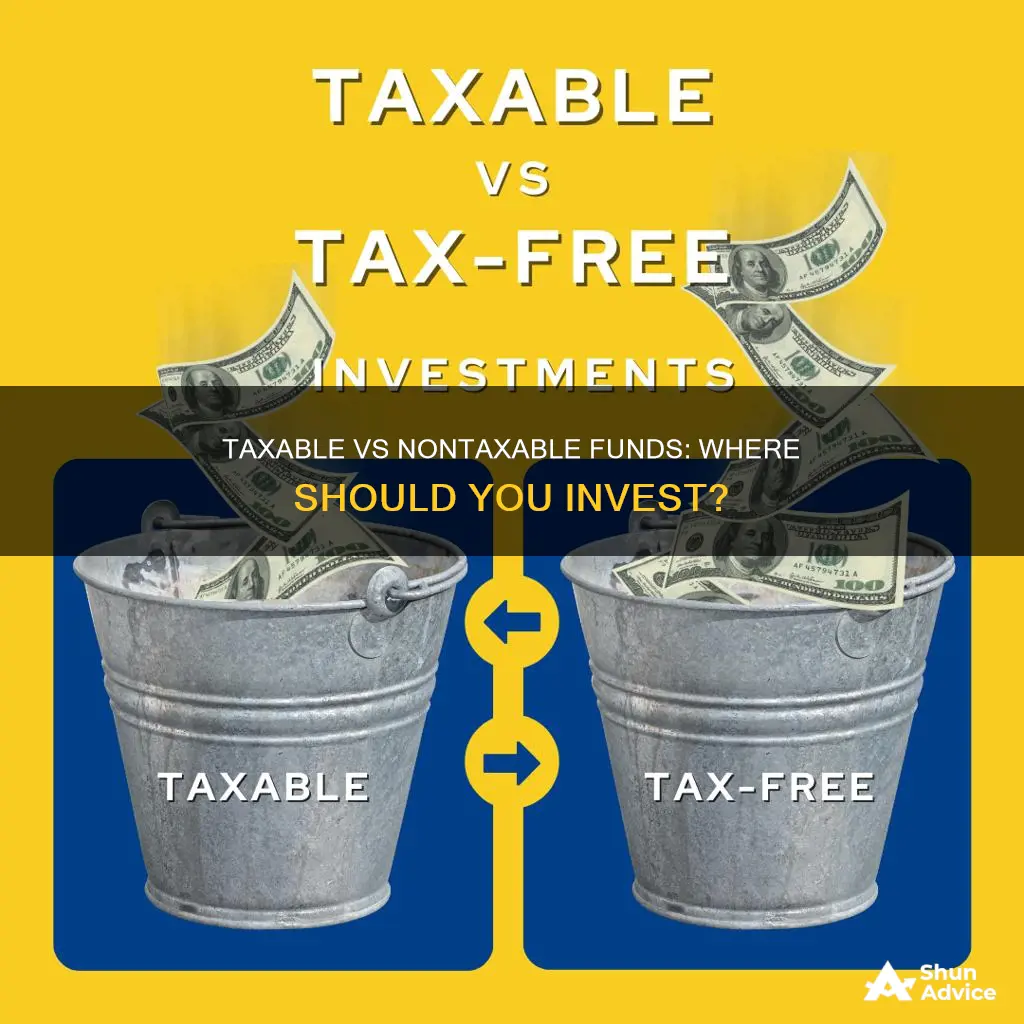
There are two main types of investment accounts: taxable and tax-advantaged. Taxable accounts, such as brokerage accounts, offer more flexibility than tax-advantaged accounts like IRAs and 401(k)s. The returns on taxable accounts are taxed according to how long the asset was held, with investments held for over a year subject to long-term capital gains rates, and those held for a year or less taxed as short-term capital gains. On the other hand, tax-advantaged accounts are either tax-deferred, like traditional IRAs and 401(k) plans, or tax-exempt, like Roth IRAs and Roth 401(k)s. While tax-deferred accounts provide an upfront tax break, investors pay taxes when they withdraw their money in retirement. Tax-exempt accounts, on the other hand, are funded with after-tax dollars, but investments grow tax-free, and qualified withdrawals are tax-free.
| Characteristics | Values |
|---|---|
| Taxable Accounts | Brokerage account |
| Fewer restrictions | |
| More flexibility | |
| Returns are taxed depending on how long the asset was held | |
| Investments held longer than one year are subject to long-term capital gains rates of 0%, 15%, or 20% | |
| Investments held a year or less are subject to short-term capital gains and taxed according to an individual's ordinary income tax bracket | |
| Tax-Advantaged Accounts | Tax-deferred or tax-exempt |
| Traditional IRAs and 401(k) plans | |
| Investors pay taxes when they withdraw their money in retirement | |
| Contributions to Roth IRAs and Roth 401(k)s are made with after-tax dollars | |
| Investments grow tax-free | |
| Qualified withdrawals in retirement are tax-free | |
| Restrictions and penalties if individuals are below retirement age when they withdraw |
What You'll Learn

Taxable vs. tax-advantaged accounts
When it comes to investing, there are two main types of investment accounts: taxable and tax-advantaged. Each has its own set of advantages and considerations, and understanding the differences between the two can help investors make informed decisions about where to allocate their funds.
Taxable Accounts
Taxable accounts, such as brokerage accounts, offer investors greater flexibility and fewer restrictions compared to tax-advantaged accounts. The returns generated in taxable accounts are subject to different tax rates depending on how long the asset was held before being sold. Investments held for more than a year are typically taxed at long-term capital gains rates of 0%, 15%, or 20%, depending on the investor's tax bracket. On the other hand, investments held for a year or less are taxed according to the individual's ordinary income tax bracket.
One advantage of taxable accounts is that they provide investors with more flexibility in accessing their funds. Unlike tax-advantaged retirement accounts, there are no age restrictions on withdrawals from taxable accounts, making them suitable for goals that are a few years down the road. Taxable accounts also offer a wider range of investment options, catering to investors who want more control over their investment strategies.
Tax-Advantaged Accounts
Tax-advantaged accounts can be further categorised into tax-deferred and tax-exempt accounts. Tax-deferred accounts, such as traditional IRAs and 401(k) plans, provide an upfront tax break, allowing investors to defer paying taxes until they withdraw their money during retirement. On the other hand, tax-exempt accounts, including Roth IRAs and Roth 401(k)s, are funded with after-tax dollars. While contributions are made with money that has already been taxed, investments grow tax-free, and qualified withdrawals during retirement are not taxed. It is important to note that tax-advantaged accounts, such as IRAs and 401(k)s, have annual contribution limits and may impose restrictions and penalties for early withdrawals.
Choosing the Right Account
The decision to invest in taxable or tax-advantaged accounts depends on various factors, including an investor's tax bracket, investment goals, and time horizon. Taxable accounts may be suitable for investors seeking flexibility and immediate access to their funds, while tax-advantaged accounts can provide tax benefits that maximise returns over the long term. It is always recommended to consult with a qualified financial advisor or tax specialist to determine the best investment strategy based on an individual's unique circumstances.
A Guide to Investing in Nifty 50 Index Funds with Zerodha
You may want to see also

Tax-efficient investing strategies
Taxes are one of the biggest expenses on investments, and they can significantly impact an investor's returns. Therefore, investors should consider tax-efficient investing strategies to minimise their tax burden and maximise their bottom line. Here are some strategies to achieve tax efficiency:
Understand the two main types of investment accounts:
- Taxable accounts: These include brokerage accounts and offer more flexibility than tax-advantaged accounts. The returns on taxable accounts are taxed depending on how long the asset was held. Long-term capital gains (assets held for more than a year) are taxed at rates of 0%, 15%, or 20%, depending on the investor's tax bracket. Short-term capital gains (assets held for a year or less) are taxed according to the individual's ordinary income tax bracket.
- Tax-advantaged accounts: These include tax-deferred and tax-exempt accounts. Tax-deferred accounts, such as traditional IRAs and 401(k)s, provide an upfront tax break, and taxes are paid upon withdrawal in retirement. Tax-exempt accounts, like Roth IRAs and Roth 401(k)s, are funded with after-tax dollars, but investments grow tax-free, and qualified withdrawals are tax-free.
Choose the right investments for each account type:
- Taxable accounts: Investments that tend to lose less of their returns to taxes are suitable for taxable accounts. Examples include municipal bonds, Treasury bonds, Series I bonds, individual stocks held for at least a year, tax-managed stock funds, and exchange-traded funds (ETFs).
- Tax-advantaged accounts: Investments that lose more of their returns to taxes are good candidates for tax-advantaged accounts. This includes actively managed funds that generate substantial short-term capital gains, taxable bond funds, high-yield bond funds, and real estate investment trusts (REITs).
Diversify by tax treatment:
Consider holding investments in different types of accounts to complement your savings plans and reduce taxes. For example, you can invest in a taxable brokerage account, a tax-deferred IRA or 401(k), and an after-tax Roth account. This strategy provides flexibility in managing your taxes during retirement, regardless of your tax bracket.
Estate planning and charitable giving:
The different tax treatments of accounts can also be leveraged for estate planning and charitable giving. For example, appreciated securities from taxable accounts can be donated to charity, providing a full fair market value deduction without capital gains tax. Additionally, stocks in taxable accounts are generally preferable for leaving to heirs, as the cost basis is calculated based on the market value at the time of death.
Consult professionals:
Tax-efficient investing can be complex, and it's essential to consult a qualified investment planner, financial advisor, or tax specialist. They can help you navigate the tax obligations associated with different accounts and determine the best tax strategy for your specific situation.
Social Security's Uninvested Funds: Why and What If?
You may want to see also

Taxable investment accounts
The profits you earn from dividend income or the sale of assets in a taxable account must be reported to the IRS and are subject to taxation. The tax rate depends on how long you owned the asset before selling it. If you owned it for less than a year, it is taxed as ordinary income. If you owned it for longer, it is subject to long-term capital gains tax, which could be 0%, 15%, or 20%, depending on your tax bracket.
Benefit from Additional Liquidity
There are no age restrictions on accessing your funds in a taxable account, unlike retirement plans such as 401(k)s, annuities, and traditional IRAs, which usually have age restrictions and early withdrawal penalties. This makes taxable investment accounts ideal for goals that are a few years down the road.
Save More for Retirement
If you have already maxed out your contributions to your tax-advantaged retirement accounts, such as your 401(k) or IRA, and you have additional funds to invest, a taxable investment account is a good option. You can still minimise taxes within a taxable account by investing in tax-exempt bonds or tax-managed funds.
Avoid RMDs in Retirement
Taxable accounts do not have required minimum distributions (RMDs) in retirement, unlike certain retirement accounts, which require mandatory minimum withdrawals once you reach your early 70s. This allows you to leave your money in the market for a longer period.
Greater College Savings Flexibility
If you are saving for education expenses, a taxable investment account can complement a 529 plan or a Coverdell account, which have restrictions on how the funds can be used. With a taxable account, you have more flexibility to use the savings for any of your student's needs.
More Investment Options
A taxable investment account offers more control and a broader range of investment options for adventurous investors. For example, investing in cryptocurrency or options trading is easier through a taxable account than through a retirement account.
Maximise an Inheritance
Retirement accounts with untaxed dollars may create unexpected tax burdens for your heirs, as they are now required to clean out inherited retirement accounts within 10 years. In contrast, investments in a taxable account qualify for a tax-free stepped-up basis when you pass away, allowing your beneficiaries to inherit the gains tax-free.
Bonds vs Mutual Funds: Where Should You Invest?
You may want to see also

Tax-free vs. taxable mutual funds
When considering whether to invest in a taxable or tax-free mutual fund, there are several factors to take into account. Firstly, it is important to understand the differences between the two types of funds. Taxable accounts offer more flexibility than tax-free accounts but are taxed depending on how long the asset is held for. Tax-free accounts, on the other hand, often consist of municipal bonds and other government securities, and their returns are tax-free at both the state and federal levels.
One of the key considerations when deciding between a taxable and tax-free mutual fund is the impact of taxes on your investment returns. Taxes can be a significant expense, and choosing the right type of account can help minimize their impact. If you are in a higher tax bracket, tax-efficient investing strategies become even more important. It is worth noting that tax-free funds tend to provide lower pre-tax returns than comparable securities issued by non-governmental entities. Thus, it is crucial to compare the total after-tax returns of both types of funds before making a decision.
Another factor to consider is the level of risk you are comfortable with. Tax-free funds are often backed by the full faith and credit of the issuing bodies, typically state governments or municipalities, which can provide added comfort to risk-averse investors. Additionally, if your fund will be held in a qualified pension or retirement plan, such as an IRA or 401(k), where returns accumulate tax-deferred, there may be no need to choose a tax-free fund.
It is also important to keep in mind that different types of investments within your portfolio may be better suited to either taxable or tax-free accounts. For example, individual stocks that you plan to hold for a long period are generally better suited to taxable accounts, as you won't have to pay capital gains tax until you sell the shares. In contrast, high-dividend-paying stocks and actively managed stock funds are often better left out of taxable accounts to reduce the tax burden.
Lastly, it is always recommended to consult a qualified investment planner, financial advisor, or tax specialist to help you choose the best tax strategy for your specific situation. They can provide personalized advice and ensure that you consider all relevant factors before making any investment decisions.
Strategies to Secure Investment Funding: A Comprehensive Guide
You may want to see also

Taxable accounts for college savings
When it comes to saving for college, there are a few different types of accounts that can be used. Each has its own set of advantages and disadvantages in terms of taxes, contribution limits, and investment options. Here is an overview of some of the most common taxable accounts for college savings:
529 College Savings Plans:
529 plans are the most common way to save for a child's college education. They offer tax advantages, and the potential to earn a return on your investment. You can open a 529 plan and make post-tax contributions, which are then invested over time. While 529 plans don't have a high level of risk, you can still earn a modest return on your contributions. Any returns earned are exempt from federal taxes, and if you use the funds for qualified education expenses, your withdrawals are tax-free. Additionally, there are no annual contribution limits, and you can change the account beneficiary if your child decides not to attend college.
Education Savings Accounts (ESAs):
ESAs, also known as Coverdell accounts, are another type of tax-advantaged education savings account. Withdrawals can be used for qualified elementary, secondary, and post-secondary education expenses. However, there are income restrictions for contributing to ESAs, and contributions are limited to a maximum of $2,000 per year until the beneficiary's 18th birthday. The account must be liquidated by the time the beneficiary turns 30.
Roth IRA:
While a Roth IRA is primarily a retirement savings vehicle, it can also be used to save for college. Withdrawals from a Roth IRA are tax-free after the age of 59 1/2, including any returns earned. You can also withdraw your contributions at any time without tax or penalty, and there are no restrictions on how the money is used. However, withdrawing earnings before that age will be taxed as income, although they are exempt from the 10% federal tax penalty. The annual contribution limit for 2019 was $6,000 ($7,000 if you're 50 or older), but this limit may be reduced based on your income.
Bank Savings Account:
Using a traditional bank savings account for college savings may not offer a high return, but it provides flexibility as the funds can be used for any purpose without penalty. This can be a good option if your child decides not to attend college, as the money can be used for other financial goals or gifted to your child. For higher returns, consider a high-yield savings account.
When choosing a taxable account for college savings, it's important to consider your specific financial situation, the level of risk you're comfortable with, and the potential tax advantages offered by each account type. It's always a good idea to consult with a financial advisor to determine the best savings strategy for your needs.
Best Platforms for Direct Mutual Fund Investments
You may want to see also
Frequently asked questions
Taxable accounts, such as brokerage accounts, offer more flexibility than tax-advantaged accounts like IRAs and 401(k)s. Returns in taxable accounts are taxed depending on how long the asset was held, whereas tax-advantaged accounts are either tax-deferred or tax-exempt.
Tax-deferred accounts, such as traditional IRAs and 401(k) plans, provide an upfront tax break. Investors pay taxes when they withdraw their money in retirement. Tax-exempt accounts, such as Roth IRAs and Roth 401(k)s, are funded with after-tax dollars, but investments grow tax-free, and qualified withdrawals in retirement are tax-free.
Taxable investment accounts offer greater liquidity and flexibility. There are no age restrictions on accessing funds, and they can be used for a variety of financial goals, including retirement and education savings. They also offer more investment options for adventurous investors.
Tax-free mutual funds are typically made up of municipal bonds and government securities, which provide tax-free returns at the state and federal levels. They are also considered lower-risk investments as they are backed by the full faith and credit of the issuing bodies.
When choosing between a taxable and tax-free fund, consider your expected returns and your tax bracket. Compare the after-tax rate of return by multiplying your expected rate of return by (100% - your tax rate). If you are in a high tax bracket, the tax advantages of a tax-free fund may be more beneficial.







